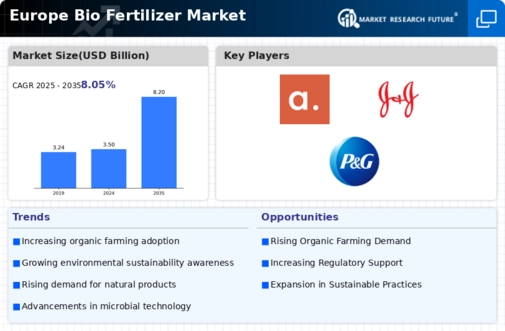Market Growth Projections
The Global Europe Bio Fertilizer Market Industry is projected to experience substantial growth in the coming years. The market is expected to reach 3.5 USD Billion in 2024 and is anticipated to grow to 8.2 USD Billion by 2035. This growth trajectory indicates a compound annual growth rate of 8.05% from 2025 to 2035, reflecting the increasing adoption of bio fertilizers in agricultural practices. The rising demand for organic produce, coupled with supportive government policies and technological advancements, is likely to drive this growth, positioning bio fertilizers as a key component in sustainable agriculture.
Rising Awareness and Education
The Global Europe Bio Fertilizer Market Industry is benefiting from increased awareness and education among farmers regarding the advantages of bio fertilizers. Agricultural extension services and educational programs are disseminating knowledge about the benefits of bio fertilizers, including improved soil health and enhanced crop productivity. This growing awareness is encouraging farmers to transition from conventional fertilizers to bio alternatives. As more farmers recognize the long-term benefits of bio fertilizers, the market is likely to expand, supported by a collective effort to promote sustainable agricultural practices across Europe.
Government Support and Regulations
Government initiatives and regulations play a pivotal role in shaping the Global Europe Bio Fertilizer Market Industry. Various European nations are implementing policies that promote sustainable agricultural practices, including the use of bio fertilizers. For instance, the European Union has set ambitious targets for reducing chemical fertilizer usage, which encourages farmers to adopt bio fertilizers. This regulatory support is expected to drive market growth, as it aligns with the EU's Green Deal objectives. The market is anticipated to grow from 3.5 USD Billion in 2024 to 8.2 USD Billion by 2035, reflecting the positive impact of government policies on bio fertilizer adoption.
Increasing Demand for Organic Produce
The Global Europe Bio Fertilizer Market Industry is witnessing a surge in demand for organic produce, driven by consumer preferences for healthier food options. As consumers become more health-conscious, the need for organic farming practices that utilize bio fertilizers is growing. In Europe, the organic food market is projected to reach approximately 50 billion USD by 2025, indicating a robust market for bio fertilizers. This shift towards organic farming not only enhances soil health but also aligns with sustainability goals, making bio fertilizers an essential component in meeting the rising demand for organic products.
Environmental Concerns and Sustainability
Growing environmental concerns are propelling the Global Europe Bio Fertilizer Market Industry forward. The adverse effects of chemical fertilizers on soil health, water quality, and biodiversity have prompted a shift towards more sustainable agricultural practices. Bio fertilizers, which enhance soil fertility without harming the environment, are increasingly favored by farmers. The European Commission's commitment to sustainability and biodiversity conservation further supports this trend. As consumers and policymakers alike prioritize eco-friendly solutions, the demand for bio fertilizers is expected to rise, contributing to the industry's growth in the coming years.
Technological Advancements in Bio Fertilizers
Technological innovations are significantly influencing the Global Europe Bio Fertilizer Market Industry. Advances in microbial technology and formulation techniques are enhancing the efficacy of bio fertilizers, making them more appealing to farmers. For example, the development of new strains of beneficial microorganisms has improved nutrient availability and soil health. These advancements not only increase crop yields but also reduce dependency on chemical fertilizers. As a result, the market is expected to experience a compound annual growth rate of 8.05% from 2025 to 2035, driven by the adoption of these innovative bio fertilizer technologies.














Leave a Comment